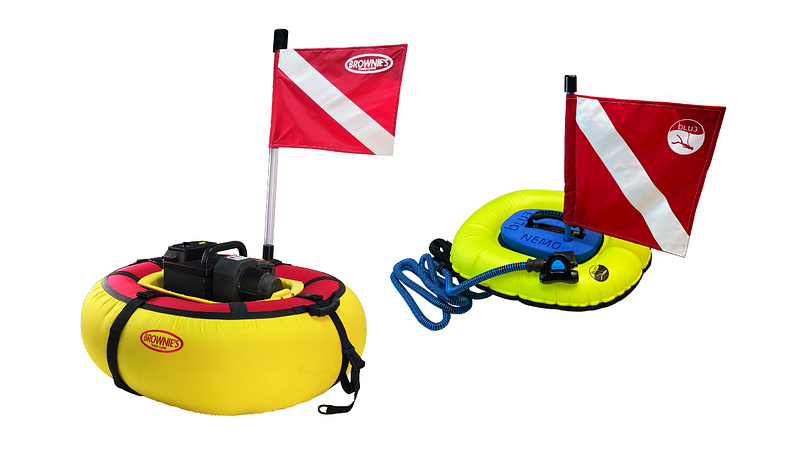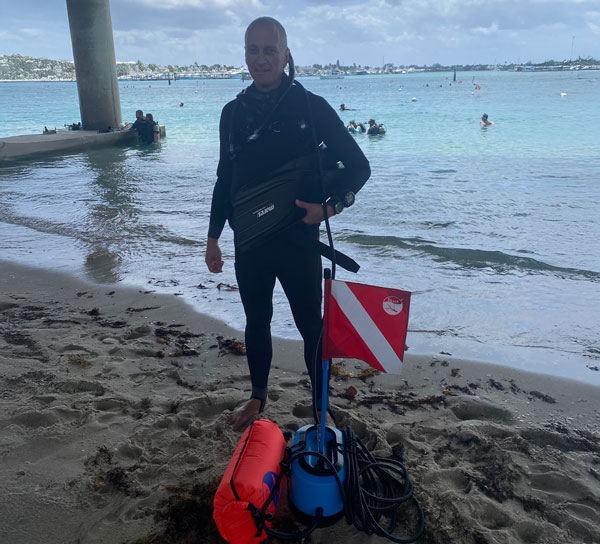What Is Tankless Diving? Is It Good or Evil? What’s in It for the Scuba Industry?
Surface-supplied air dive systems. What are they? Who are they for? Is it scuba diving or snorkeling? Could they help to revitalize the dive industry?
I recently read comments about surface-supplied air dive systems on a post in a Facebook group, and it got me thinking. The original poster was wondering if he should buy a unit for his wife to enjoy the ocean. He was a certified scuba diver. She was not.
Some of the comments were pretty extreme.
“If You whanna die… use it.”
Ya! Grammar and punctuation are not readily visible on Facebook, but that is a whole different story!
“Take a gun and shoot her, it is faster.”
So these Facebook “experts” think surface-supplied air dive systems are dangerous.
“Danger!” Isn’t it one of the reasons many people stay away from traditional scuba diving as well? Yet, we all know how safe scuba diving can be – when performed safely!
Remember when nitrox was evil? Certification agencies offering nitrox diving courses were banned from exhibiting at the DEMA Show, our annual dive industry tradeshow. Nitrox was gonna kill people and the industry! Nowadays, it’s the complete opposite. Scuba divers of all ages, especially older divers, use nitrox on all of their dives as an added safety precaution to limit nitrogen absorption.
It’s easy to be scared of something we know nothing about. It’s human nature. We feel comfortable with what is familiar. But with that mentality, there would be very little progress in this world!
On that Facebook group, however, it wasn’t all doom and gloom. There were counter voices.
“My buddy has one. And we dive shallow river dives with it off of kayaks. So much easier than hauling around tanks. Really awesome system.”
Quite a few comments were related to how much more convenient such a system was.
“I’ve spent many, many hours with surface supplied air doing underwater repairs and construction on docks and boats. It’s a great way to go.”
That’s an interesting observation. There sure is a lot of yachting around the world!
Surface-supplied air systems have been around for quite some time. We sold hundreds of them in a chain of dive stores I was managing in South Florida. Throughout those years, I never heard of a single incident. During the same time period, numerous scuba diving accidents happen in the Florida Keys – including death.
Today, I just checked; all the main online scuba retailers carry these units in their inventory. There is a market for it.
Therefore, I suggest we take a step back and look seriously at this type of equipment. Could it carry a hidden potential for the future of diving?
This post is part of our Blueprints 4.0 for a Healthier Dive Industry Business Model series by the Business of Diving Institute and Darcy Kieran, author of:
Table of Contents
What is Scuba Diving?
Beyond the meaning of the acronym, what is scuba diving?
At its core, scuba diving is about exploring or “experiencing” the rest of our world. More than 70% of this planet is water, and there is so much life underwater!
Scuba diving is also about the feeling of weightlessness and the thrill of breathing underwater. When I started scuba diving, I enjoyed that feeling so much that I would regularly hover underwater in my pool just for that feeling.
Now, let’s see. Where does it say that I need to carry the current scuba diving equipment configuration to do any of that? The prevailing scuba unit configuration has been around forever. Sure. That is not a reason to declare it as the best and only configuration. Let’s think about it.
When I look at a surface-supplied air system, I see a tool that lets me explore the underwater world, experience weightlessness, and breathe underwater. And as a (former) dive store owner, I see an additional source of revenue.
Perhaps we are so focused on the word ‘scuba’ (self-contained underwater breathing apparatus) that we forget scuba gear is simply a means to an end. Perhaps we don’t need the “self-contained” part to enjoy what we now know as “scuba diving.” Let’s see.
What is ‘Surface-Supplied Air’ or ‘Tankless’ Diving?
Fundamentally, it is an air compressor sitting on a tube that floats at the surface. Long hoses are attached to that compressor. At the other end of the hose, there’s a second-stage regulator off of which the underwater explorer breathes air.

These units have many names.
They are often referred to as “hookahs” because they share a familiar look with the instrument used for smoking tobacco, cannabis, and opium. I suggest we stay clear of that name for marketing reasons. Google blocked all ads we placed for hookahs even if it was not drug-related - because they assumed it was drug-related!
These units are also referred to as surface-supplied diving and surface air systems. My favorite name is tankless diving. It’s short! And it states quite clearly what it is.
In South Florida, you will hear people asking for a Brownie – not the chocolate version of it! Nor the other kind you are thinking of! The most popular surface-supplied air unit in that part of the world is manufactured and distributed by Brownie’s Marine Group under the brand name Brownie’s Third Lung.
A California company has been marketing a similar concept under the name SNUBA, a half-breed name created from a marriage between snorkeling and scuba diving. In their case, the floating raft actually carries compressed air in scuba cylinders. They are still dependent on having access to refilling scuba cylinders.
In both cases, participants need a mask and fins, which, we have to say, is often one of the most profitable retail departments in a local dive shop.
Current Challenges in The Scuba Diving Industry
We discussed the need for a new business model in the dive industry. We believe a Blue Ocean Strategy is the way to go because incremental changes are no longer sufficient. The dive industry is shrinking. Scuba diving participation is on the decline because there are more people dropping out than people getting into scuba diving. We are not successfully pulling in non-divers.
Business as usual is leading us nowhere, fast.
There are numerous reasons for this negative trend, including:
- It is complicated to go scuba diving. You need a plastic card from SDI and a pile of stuff from Beuchat!
- Scuba diving is not readily available wherever there is water. You need a nearby source of compressed air.
- Our dive industry marketing and processes are still geared toward baby boomers for whom scuba diving was a lifelong dream and a lifestyle. Younger generations are more likely to be merely interested in going underwater here and there, casually, when they feel like it. It’s just one of the numerous activities they would do on a vacation trip, and as such, they won’t travel with an enormous duffel bag full of heavy scuba diving equipment.
By the way, I don’t believe we need to make scuba diving ‘easy’ to grow this industry. Many people enjoy tackling a challenge. But we need to make it more ‘convenient.’ There are too many hoops we require our clients to jump through before experiencing the underwater world for themselves.
Is surface-supplied air the solution to all the dive industry’s problems? Of course, not. But let’s keep an open mind at this stage. It’s always helpful to think outside the proverbial box, so let’s glance at the pros and cons.
Advantages of Surface-Supplied Air Diving Systems
As I said before, when I was selling tankless diving systems by the dozens in South Florida, I never gave it much thought. Now that I am looking at it more carefully, I can see numerous benefits to such systems.
Making the Underwater World More Accessible to Snorkelers
Snorkeling is much more prevalent than scuba diving. For instance, in the USA, about 3 million people participate in scuba diving while 7.5 million Americans engage in snorkeling. It’s more than double.
We tend to be a bit snobby in the dive industry. I’ve heard snorkeling being referred to as the equivalent of kissing through a screen door. Many dive resort operators improve their dive charter boat profitability by offering snorkeling tours – but it’s often an afterthought and they are not passionate about it.
Instead of looking at snorkelers with a condescending look, we could figure out how to further engage with these people. They are clearly interested in the underwater world, and they have no problem jumping into the ocean.
For a snorkeler to get closer to the reef, the mountain to climb is steep. We all know the process. It’s all about courses and plastic certification cards – for days! And then, you need complicated and heavy equipment. Now, let’s compare that to a surface-supplied air system. Doesn’t it look like a much easier ‘next step’ for a snorkeler? That’s how SNUBA came up with their name.
“SNUBA is a shallow water diving system that bridges the gap between snorkeling and scuba. SNUBA is fun, friendly, unintimidating, simple to use, and does not require you to wear heavy or cumbersome equipment.” ~Source: SNUBA.
Simplifying The ‘Production Chain’ to Deliver Air Underwater
When we manage a local dive shop, we are really managing six different businesses under one roof, one of which is a fill station. Compressed air, scuba cylinders, and fill stations are part of what we consider fundamental parts of a local dive shop. Could we be a bit myopic?
Let’s take a step back and look at what the goal really is.
People need air to breathe underwater. That’s it!
Let’s look at how we currently satisfy this need.
First, we need a big compressor sitting in a dive shop somewhere. Then we use heavy pieces of metal called scuba cylinders and store air in them. We transport these containers to the dive site. We use a vest (BCD) to throw that heavy piece of metal on our back. We walk the best we can to the water entry point, with that thing on our back. We jump in. We go underwater. We breathe air.
Now, let’s look at a surface-supplied air system.
You start the mini compressor and have it float in the water. You grab a hose, go underwater, and breathe air.
As an industrial engineer, I always like it when we can simplify processes!

Opening More Dive Sites
Because scuba diving depends on access to an air compressor to refill dive cylinders, we cannot readily explore any and all water bodies.
When I lived up North and got tired of teaching people how to remove and replace a mask underwater, I went exploring with a friend of mine. We had to carry a portable gas compressor and our scuba cylinders. That is not something you can easily do unless you are driving an F150 or the like.
But that is something anybody can do with these fairly compact tankless diving systems.
In reality, tankless diving is converting all bodies of water into a potential dive site. Availability of compressed air and scuba cylinders can be an issue in numerous tropical islands around the world. With a tankless system, we can go exploring anywhere we want with just a kayak or a stand-up paddleboard.
Reducing the Physical Limitations We Impose on People With Current Scuba Diving Gear
Our current gear configuration to go scuba diving is cumbersome and heavy. I do not have clear statistics on the reasons why scuba diving remains a male activity, but I feel safe venturing that many women don’t feel the need to demonstrate how macho they are by carrying bulky stuff on their back!
The same thing can be said of children and any smaller person.
Surface-supplied air systems fix that problem.
Disadvantages of Surface-Supplied Air Diving Systems
What would be the reasons not to embrace this new type of underwater air delivery system?
Facing Dangers Because of a Lack of Training
The danger of using such a system without proper training appears to be one of the top reasons people are scared of these diving units.
It’s a valid concern. Any activity we engage in as humans can be dangerous if we don’t know what we’re doing. Is it more an issue with surface-supplied air systems than it is with scuba diving equipment?
Because it is compressed air, people face the risk of lung overexpansion injuries if they hold their breath and rush to the surface. However, from my experience selling them, these units come with clear liability releases (the dangers are not hidden) and training instructions.
Training on safe usage of a Brownie’s Third Lung is readily available online (just like all of our scuba diving courses) and free of charge with a unit’s purchase. Could this be what is truly scaring the dive industry? Imagine if scuba lessons were free with the purchase of a Beuchat regulator! That would generate quite a shockwave through the industry. The valuation of a few large DEMA corporate members would fall off a cliff pretty fast!
Perhaps there’s a new dive industry paradigm around the corner.
BLU3 also offers online training for their battery-operated surface-supplied air systems.
The thing is… If we are concerned about safety (and revenues), perhaps we should embrace these units to organize training and guided tours. At the moment, people simply buy them and use them without us because I don’t know of any dive center actively promoting such training.
In tropical vacation destinations, offering the underwater world experience with a tankless diving system could be easier for us, more convenient to the customer, and probably more profitable and safer than the traditional, disastrous Discover Scuba Diving experience.
Being Limited to Shallow Water
With a surface-supplied air system, there is a hose between the underwater explorer and the surface unit. Therefore, there is a limit to how deep you can go. The length of the hose limits you.
It means that there will always be a need for scuba diving equipment. There will always be tech divers exploring and penetrating wrecks in 200 feet (60 m) of water. But most of what is of interest to underwater tourists sits in shallow water. Therefore, being “limited to shallow water” is not really a limitation.
This is how Brownie’s Marine Group explains the relation between depth, complexity, and equipment choice:

Furthermore, the limits imposed by the hose’s length could easily be said to be an added safety feature. As divemasters and instructors, we’ve all lived through the nightmare of that scuba tourist constantly drifting away from the group or sinking too deep. With these hoses, we know where our customers are. They cannot go too far. They cannot go too deep.
Facing the Danger of Carbon Monoxide Poisoning
Some of these small floating compressors are gas-operated. We certainly don’t want carbon monoxide emanating from the compressor to find its way into the compressed air being pushed to underwater explorers. I had the same concern when operating my portable air compressor from the trunk of my F150 in remote areas.
It’s a valid concern. People need to follow instructions, and if we are concerned about safety, let’s make it our business to help people be safe.
However, gas units are disappearing. What I find quite interesting is the market growth of battery-operated air compressors for surface-supplied air delivery systems. The battery obliterates the carbon monoxide poisoning risk, making the units even more convenient. We are no longer dependent on access to a traditional air compressor nor a source of gas. We can simply plug and recharge the unit in a hotel room, just like we do with our smartphones.
The car industry is converting itself to electric cars. It’s happening at various speeds depending on the country, but that is where we’re going. I guess that similarly, eventually, most surface-supplied air delivery systems will be battery-operated.
The Verdict on Tankless Diving
At the moment, there is a growing market for these systems. They exist. They are being sold. They are being used.
They are purchased and used by snorkelers and scuba divers. Yet, they remain mostly outside the confines of what we define as being the dive industry, where we continue to run our businesses as we’ve always done, with concepts from the past.
Just like the recreational scuba diving world was slow at accepting nitrox, we are slow at accepting and embracing surface-supplied air delivery units. By acting like that, we are missing opportunities.
I’d like to hear your thoughts about surface-supplied air (tankless) diving systems, as well as your experience using these units with clients. Please contact me.
If you found the information on this page valuable, would you consider buying me a coffee?
Either way, let’s work together on “raising the bar” in the dive industry to satisfy today’s consumers!
Your Dive Industry Compass
Scuba Diving Market Research, Surveys, Reports & Statistics
Blueprints 4.0: A Healthier Business Model
Scuba Diving Industry Structure, Competitive Analysis, Business Models & Strategies for Growth With The New Scuba Diver
Living The Scuba Dream
Plan Your Scuba Instructor Career & Deep Dive the Plan
You may also be interested in The Immersion Zone (our podcast), Scubanomics (our newsletter for dive professionals), and our published books & reference guides.





